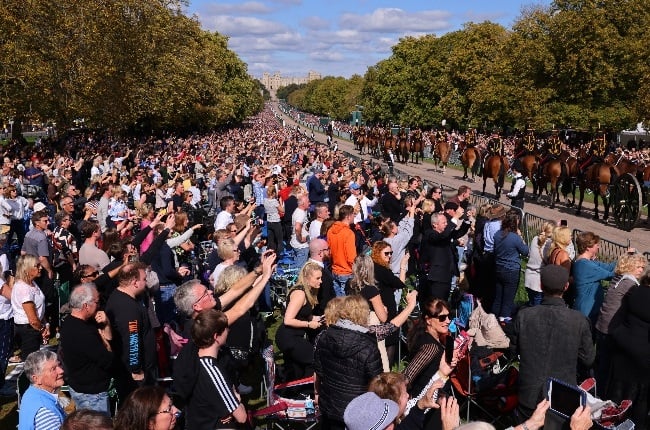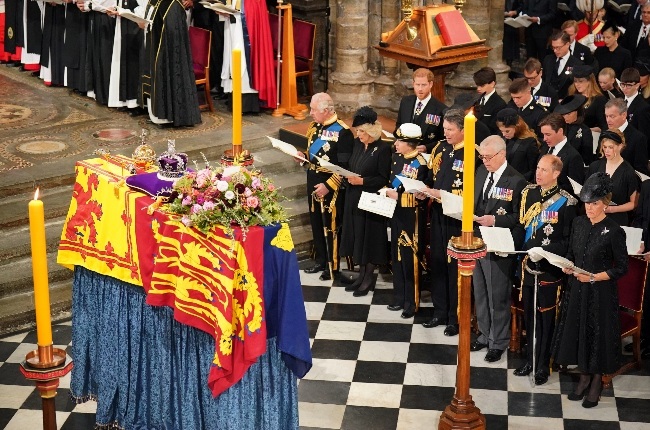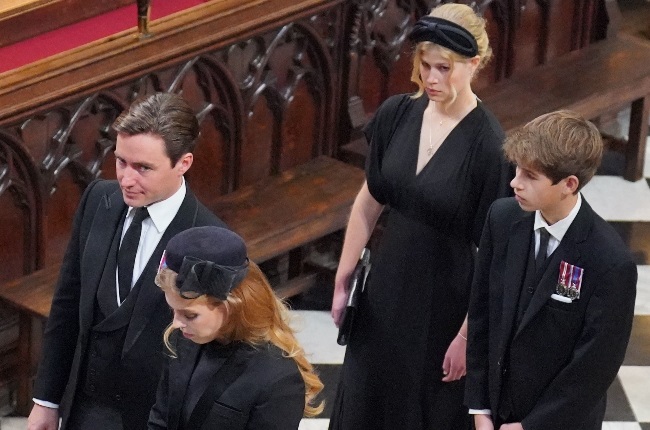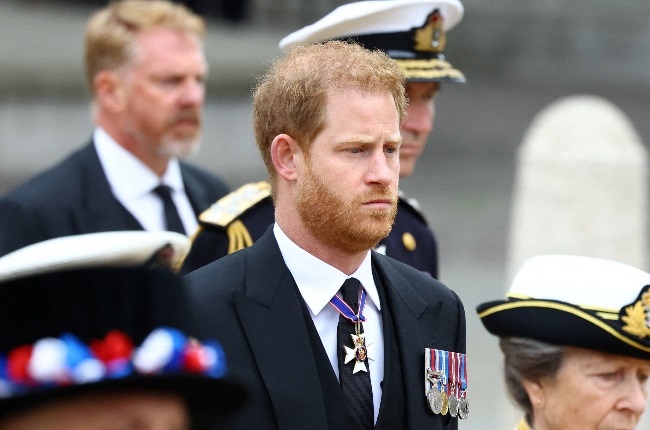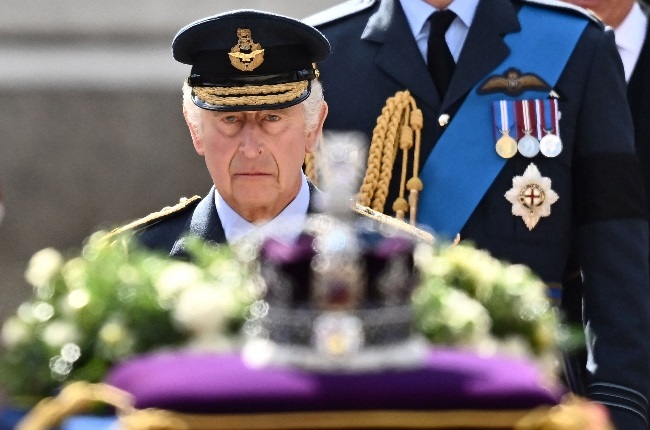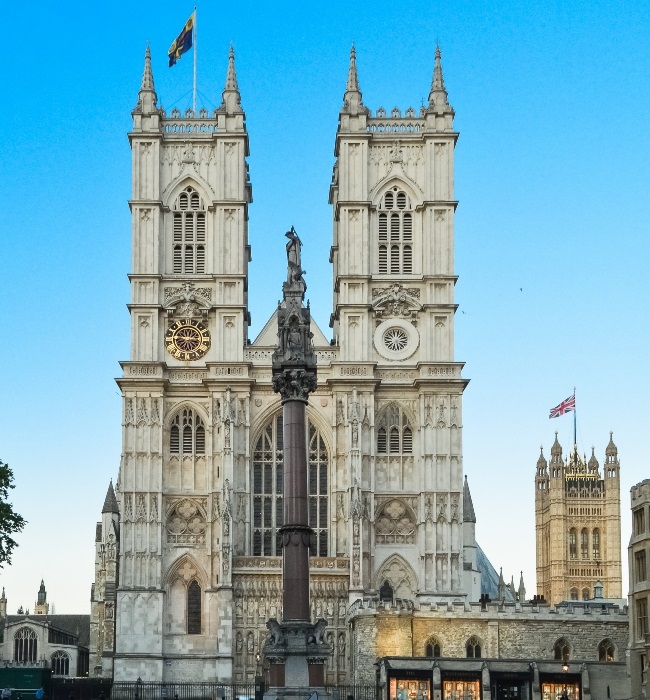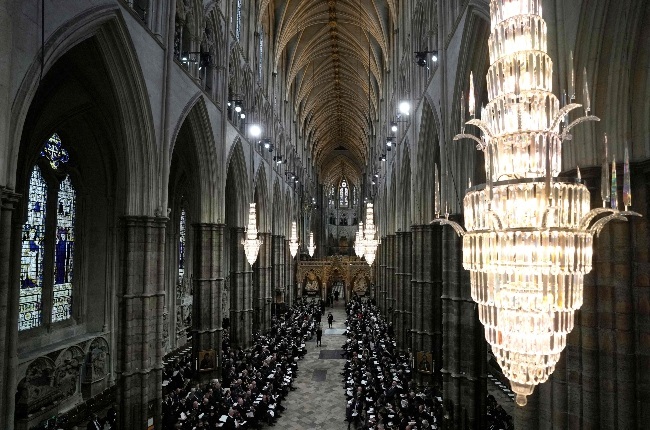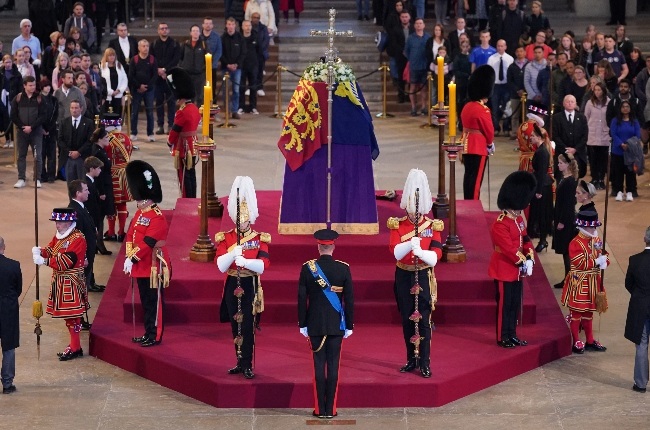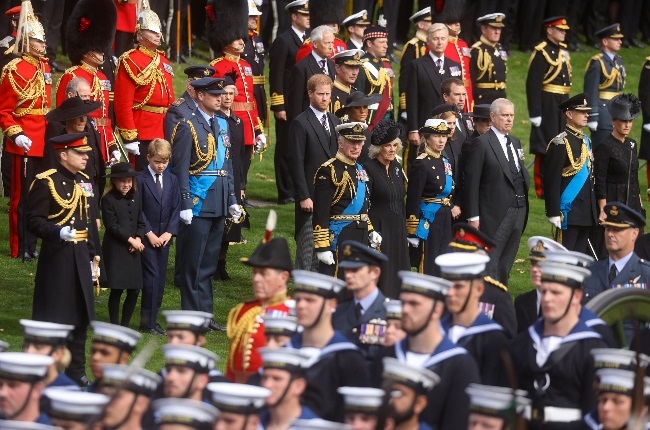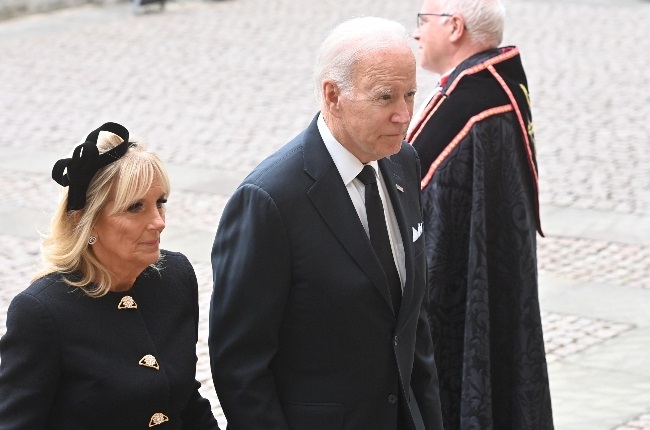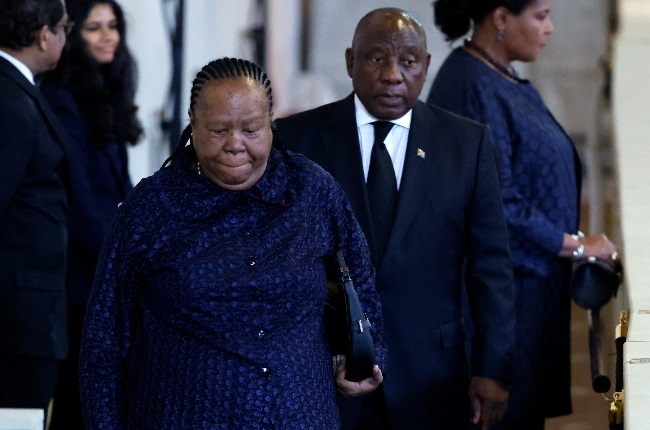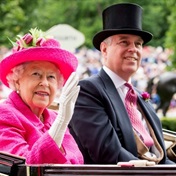
As the first strains of the funeral service started from within Westminster Abbey, a sombre silence descended on the hundreds of thousands who’ve gathered in London to say goodbye to the extraordinary woman who’d reigned for 70 years.
You could hear a pin drop in a goosebump-inducing moment signifying the final farewell to Queen Elizabeth II had begun. The passing of the queen was always going to be a momentous occasion but the sheer scale of it all has been nothing short of breathtaking.
The broadcast of the funeral was expected to be the most-watched TV event in history, attracting more viewers than the 2,5 billion who watched Princess Diana’s funeral.
More than 2 million people descended on the capital for the funeral and close to a million people queued to see her lying-in-state, braving the cold for up to 24 hours to spend a few minutes in Westminster Hall to view her coffin.
As the day of the funeral neared, thousands of people camped overnight along the route of the procession.
YOU arrived in central London shortly after 5am and the streets were buzzing with police, army officers and security guards. Near the abbey pavements were nearly impossible to navigate – people were sleeping rough on the streets, on wall ledges, and under trees not to miss out.
Rebecca Baker and her 12-year-old daughter, Flello, camped in tent in an alcove near the abbey and managed to get a few hours’ sleep.
“It wasn’t too bad,” Rebecca said. “We wanted to do it to say goodbye to the queen.”
Andrea Ragsdell and her partner, Rob Childs, slept in a single sleeping bag.
“It was quite a noisy night,” Andrea said. “But there were hundreds of Portaloos around the corner and we had McDonald’s for dinner.”
Her funeral has been called a once-in-a-lifetime event and the enormity of it is unlikely to be experienced again. Her passing has triggered global grief on an unprecedented level.
“Collective grief has nothing to do with whether we knew the person,” grief specialist David Kessler says.
“That person was part of our lives without ever meeting them. Iconic figures like Queen Elizabeth become the backdrop to our lives and they also connect us to ourselves. We remember not just their milestones but how their milestones connected to ours.
“The queen dying is not only the end of her life, but it reflects our own passages through life.”
And on 19 September 2022 the body of the woman who had been that constant backdrop for seven decades was finally reunited with the people she so loved: her mother, her father, her sister – but most importantly Prince Philip, her “strength and stay” and the only man she ever loved.
As the funeral service came to an end the sounds of God Save the King rang out through those outside the church.
And when the coffin left on the gun carriage, followed by Charles and the royal family, a ripple went through the crowd: this was the last glimpse they would have of the woman who had been part of their lives for decades.
It was a moment of immense emotion and history, the scale of which will never be witnessed again.
A FAMILY IN MOURNING
The queen was always known to be stoic, rarely showing emotion in public. And her family tried to emulate that – but not quite with the same success.
Grief was etched on the faces of the royals as they entered Westminster Abbey, led by King Charles III and Queen Camilla.
The new monarch was followed by his immediate family: Princess Anne and her husband, Sir Timothy Lawrence; Prince Andrew; Prince Edward and wife, Sophie; Prince William and wife Princess Kate with their two eldest children, Prince George and Princess Charlotte, a little dark hat atop her head; and Prince Harry and wife Meghan.
Other members of the royal family followed, including Anne’s son, Peter Phillips.
Charles teared up during the service as did Andrew. Anne is most like her mother, says body language expert Judi James.
“We have seen Charles watery-eyed over his ‘darling Mama’ and we have seen the other top-tier royals offering mutual hugs and other forms of unity and sympathy as they weep and comfort each other together. But Anne seems to have taken on the role of offering quiet strength and stability throughout.”
A FITTING VENUE FOR A FAREWELL
The queen’s funeral marked the first time in 260 years Westminster Abbey was used for a sovereign’s funeral – the last time was for the service of George II in 1760.
It’s also the first time since the funeral of former prime minister Winston Churchill in 1967 that a state funeral was held at the abbey. It was Her Majesty’s wish her service be held there.
The abbey was the venue of momentous occasions for her: it was here she and Philip were married on 20 November 1947 and where she was crowned on 2 June 1953.
The abbey is also where the queen said goodbye to her mom, the Queen Mother, in 2002 and was the venue for the funeral of Princess Diana in 1997. Both women had ceremonial funerals – the same as Prince Philip – which is like a state funeral but not as formal and it’s not funded by taxpayers.
The funerals of kings and queens are usually held at St George’s Chapel in Windsor but the queen wanted it at Westminster because she wanted as many people as possible to be able to attend.
St George’s Chapel holds 800 people, but the abbey can accommodate 2 000 and its location in central London is also a better place for large crowds to gather.
The abbey fitted in with her way of thinking, a royal aide says. “She wanted people to share in the day. She thought of other people right to the end.”
A SOLEMN CEREMONY
The service, led by the Dean of Westminster, Dr David Hoyle, was filled with meaningful music.
The queen was consulted on all the arrangements before she died and her personal taste is reflected in the final selection.
It featured three hymns, two anthems and two new works by Scottish composer Sir James MacMillan, and Master of the King’s Music, Judith Weir specifically composed for the funeral.
The first hymn, The Day Thou Gavest Lord is Ended, was sung after Hoyle gave the bidding prayer.
The second, The Lord is my Shepherd, was one of the queen’s favourite pieces of music and the same hymn was sung on her wedding day in 1947.
The third – Love Divine, All Loves Excelling – was sung after The Lord’s Prayer was read. Towards the end of the service The Last Post was sounded by the State Trumpeters.
Then, after a two-minute national silence, The Reveille was sounded by the State Trumpeters, followed by the national anthem, God Save the King.
Sleep, Dearie, Sleep was played by the Sovereign’s Piper of the Royal Regiment of Scotland as the coffin and processions left the church.
HER FINAL RESTING PLACE
At the end, the queen returned to her beloved Windsor Castle, her home for the past two years.
Her coffin travelled in procession from Wellington Arch in London to St George’s Chapel at Windsor, a journey of about two hours.
A committal service was held at St George’s Chapel. Her Majesty had a hand in selecting the final elements. These included several of the organ pieces, which were arranged by William Henry Harris, organist at the Royal Chapel from 1933 to 1961.
He’d inspired the young queen’s interest in music and taught her to play the piano. He also wrote the hymn, Bring Us, O Lord God, which was sung as part of the service.
The service was led by the Dean of Windsor, David Conner, and featured chaplains from three of the queen’s favourite residences – the rector of Sandringham, the minister of Crathie Kirk, the church near her Balmoral Estate, and the Royal Chapel in Windsor Great Park.
It was an emotional moment when the Crown Jeweller removed the Instruments of State from the coffin, the orb, sceptre and Imperial crown.
Afterwards Charles laid the queen’s Company Camp Colour of the Grenadier Guards on the coffin and the head of the queen’s household, the Lord Chamberlain, broke his Wand of Office and placed it on the coffin.
The service ended with the Archbishop of Canterbury pronouncing his blessing and the congregation singing God Save the King.
Away from the cameras, the king and the royal family gathered for a private burial service at St George’s Chapel conducted by the Dean of Windsor David Connor.
“The service and burial will be entirely private, given it is a deeply personal family occasion,” a palace official said.
This one was for her nearest and dearest only, after a week of public events. It’s a fitting finale for a woman who lived a life of duty and service.
A woman who, despite being a global figure and one of the most photographed people in the world, was also deeply private.
A COFFIN FIT FOR A QUEEN
Her Majesty’s casket weighed 250kg and was lined with lead as to seal it from moisture, preserving the body for longer and preventing odour from escaping.
The coffin, made from English oak, was ready for more than 30 years. Leverton & Sons, an independent family firm of undertakers who worked on royal funerals since the early 1990s, inherited the coffin from the previous firm of royal undertakers.
English oak is rarely used for caskets now, Andrew Leverton, owner of the firm, told The Times.
“Oak coffins are made from American oak now – I don’t think we could use English oak for a coffin anymore. It would be too expensive. “The queen’s coffin has been ready for decades because it’s not something you can just make in a day.”
Because the coffin is so heavy, it needed to be carried by eight burly pallbearers. They had to be at least 1,85m tall and had to wear rubber boots instead of their usual wood and steel footwear to prevent slipping.
Highly symbolic items were on the coffin.
- The imperial state crown
Resting poignantly on the head of the casket was the dazzling crown worn by British monarchs after their coronation and at the state opening of parliament. It has a frame of solid gold and contains over 3 000 jewels, including 2 868 diamonds, 273 pearls, 17 sapphires, 11 emeralds and five rubies. It was made in 1937 for the queen’s father, King George VI.
One of the crown’s diamonds is the Cullinan II, which is derived from the Cullinan I, the biggest uncut diamond ever unearthed, which was mined in South Africa.
- The sovereign orb
The orb is presented to British monarchs at their coronation and serves as “a symbol of divine power over the world”.
It was originally made in 1661 for Charles II’s coronation and has been used for every royal coronation since.
The orb is made of gold and mounted with emeralds, diamonds, rubies, sapphires, pearls and one amethyst.
- Sovereign’s sceptre
The one-metre-long sceptre, which is also part of coronation regalia dating back to 1661, represents the monarch’s power on Earth. It holds a piece of the Cullinan I diamond – also known as the First Star of Africa – which was added by King George V in 1910 and has 333 diamonds, 31 rubies, seven sapphires, one amethyst, six spinels and 15 emeralds.
- The flowers
The wreath atop the coffin at the state funeral features pink roses and rosemary and plants from the gardens of Buckingham Palace, Clarence House and Highgrove House.
In the centre of the wreath was a sprig of myrtle taken from the queen’s wedding bouquet.
The note in the centre from her son and heir read: “In loving and devoted memory. Charles R.”
BURIED IN BELOVED ITEMS
The queen had an impressive jewellery collection consisting of over 300 pieces but it’s believed she was buried in just two simple items: a pair of signature pearl earrings and her wedding ring, which is made of Welsh gold.
Princess Anne will inherit her mother’s engagement ring, which Prince Philip helped to design.
It contains 11 natural diamonds taken from a tiara owned by Prince Philip’s mother, Alice of Battenberg, and is reportedly worth around £150 000 (R3 million).
Royal expert Mok O’Keefe says Her Majesty’s wedding band is the only piece of jewellery she needed to be buried with.
“This act of love seems fitting for a woman who actively enjoyed the simple things in life and, because of her strong faith, believed she would enjoy the riches of heaven.”
THE GUN CARRIAGE
Her Majesty’s coffin was taken from Westminster Hall to Westminster Abbey by the 123-year-old state gun carriage, which was drawn by 142 Royal Navy service personnel.
The tradition of a gun carriage to transport a monarch’s body to its final resting place began with Queen Victoria in 1901.
As the monarch’s coffin travelled through London during icy, cold weather an accident happened as it went up a hill. An eyelet hole on one of the horse’s harnesses snapped, breaking the hitch to the hearse.
In a panic, the horses started bucking and crew members from the royal navy were quickly ordered to step in, unharness the horses and haul the gun carriage with ropes the rest of the way.
To prevent another mistake that could lead to disaster in front of the public it has become tradition for navy seamen to carry the gun carriage by hand. The gun carriage has been looked after by the royal navy since 1901 when it was removed from active service.
She wanted her funeral to include military elements and to be buried as a soldier’s daughter as a nod to her father, Prince Edward, Duke of Kent, who was a successful British general.
Since then the carriage – which weighs 3 000kg – has been used in the funerals of King Edward VII (Victoria’s son), King George V, King George VI and Winston Churchill.
THE MILITARY UNIFORMS
British royal family dress code rules state working royals wear uniform for major events.
In the events leading up to the funeral, King Charles, Princess Anne, Prince Edward and Prince William wore their uniforms. Prince Andrew and Prince Harry, who are no longer working royals donned morning suits with their military medals attached for most of the period. Ironically, they are the only members of the royal family to have seen active combat.
They were permitted to don their military gear at a final vigil for the queen at Westminster Hall.
Harry is said to have been devastated that the EIIR cypher on all military uniforms was removed from his shoulder even though Andrew got to keep it on his.
Spending time in the armed forces is a rite of passage for senior male royals.
King Charles served in the Royal Air Force (RAF) and Royal Navy. As the heir to the throne he wasn’t allowed to see active combat but collected several medals.
READ MORE| WATCH| the announcement, the unexpected, the funeral: our royal experts discuss the queen's death
As king, Charles automatically becomes the British armed forces’ new commander-in-chief.
Andrew had a 22-year career in the Royal Navy and served as a helicopter pilot in the Falklands War in 1982. He still holds the title of vice-admiral of the navy – the only military rank he’s been allowed to keep.
William joined the Royal Military Academy at Sandhurst after graduating from the University of St Andrews in 2005.
In 2009 he joined the RAF and the Royal Navy and in 2010 worked as a search-and-rescue helicopter pilot in Anglesey for three years.
Harry spent 10 years in the armed services, rising to the rank of captain and doing two tours in Afghanistan.
Anne didn’t serve in the military but holds several military honours and titles and wears a Royal Navy ceremonial uniform, which she earned when she was promoted to admiral in 2012.
Prince Edward joined the Royal Marines after leaving university but dropped out before he completed the course. However, he holds many titles, including commodore-in-chief of the Royal Fleet Auxiliary and Honorary Air Commodore of the Royal Air Force Waddington.
TOGETHER AT LAST
When Prince Philip died in April 2021, he was buried in the royal vault beneath St George’s Chapel on the grounds of Windsor Castle. His coffin was lowered into the vault through a special opening in the chapel floor – but it was a temporary resting place.
The queen wanted to be reunited with her husband in death so, in accordance with her wishes, his remains will be moved so he can join the woman to whom he was married for 73 years. Her Majesty’s final resting place is in the King George VI Memorial Chapel within the grounds of St George’s Chapel.
The chapel has several sections and nooks, including the memorial chapel which the queen commissioned after her father died.
Her father, mother and her sister, Princess Margaret, are buried there too.
LEADERS FROM AROUND THE WORLD
About 500 heads of state, foreign dignitaries and members of European royal houses invited to the state funeral were urged to travel by commercial airlines and not private jet to avoid putting too much strain on London’s airports.
“This is the biggest international event we’ve hosted in decades,” a UK government source says.
Security was intense, with snipers on roofs in central London keeping a constant watch. A 20km so-called ring of steel was set up around the city as part of the largest-ever security operation in the UK, with 10 000 police officers along the funeral procession route.
VIPs were ferried to Westminster Abbey via a park-and-ride scheme – their cars were parked at a site in West London and they travelled to the abbey on buses provided by the UK government.
US President Joe Biden and his wife, Jill, were given the go-ahead to get to the church in the armoured presidential limousine known as The Beast.
They got stuck in the snarled London traffic at some point but made it to the service on time.
“The bottom line is the president of the United States would never fly commercial and/or ride on a bus,” Timothy Miller, a security specialist and former US secret service agent, told The Guardian.
The world leaders gathered for a reception before the funeral. In attendance was Queen Rania Al-Abdullah of Jordan, Queen Letizia and King Felipe VI of Spain, Sweden’s King Carl XVI Gustaf and Queen Silvia.
Others who flew in for the funeral included South Africa’s President Cyril Ramaphosa and minister of international relations and cooperation Naledi Pandor, who were seen at Westminster Hall paying respects as the queen lay in state.
Also there were Bhutan’s King Jigme Khesar and Queen Jetsun Pema. Royals and heads of state were sombre as they entered Westminster Abbey on the day of the funeral.
They included France’s President Emmanuel Macron, New Zealand prime minister Jacinda Arden, Brazil’s President Jair Bolsonaro, Fiji prime minister Vorege Bainimarama, Canadian prime minister Justin Trudeau and Wang Qishan, China’s vice president.
All living former British prime ministers were there, including Boris Johnson and Theresa May.
The logistics of dealing with invited guests was handled by the UK Foreign Office, which kept details under tight wraps.
The US president and first lady reportedly stayed at Winfield House in Regent’s Park, the official home of the US ambassador to the UK which belongs to the Crown Estate.
Information contained in Operation London Bridge indicates European royal guests stayed at Buckingham Palace while other dignitaries were booked in at Claridge’s Hotel in London.
The 190-room luxury lodge in Mayfair, London, been called “the annex to Buckingham Palace” with royals often frequenting the five-star lodge, where rooms and suites range from £1 000 (over R20 000) to £7 000 (R142 000) a night.
NUMBERS
500 toilets were placed along the route leading to the queen’s lying-in-state
453 people collapsed in the lying-in-state queue. More than 40 were taken to hospital
2 000 volunteers from ambulance services were on hand to help with medical emergencies in the queue
16km The maximum length of the queue to see the queen’s lying-in-state
75 Number of steps royal soldiers marched each minute during the funeral procession, a pace reserved exclusively for royal funerals
500 heads of state were invited to the queen’s funeral
250 extra trains were provided by rail services to ferry people into London for the funeral
£350 (about R7 000) Amount used wristbands from the lying-in-state fetched on eBay
20 Number of minutes guards stood motionless at the queen’s coffin in Westminster before they were replaced
5 900 members of the UK Armed Forces were deployed throughout Operation London Bridge
4 000 military personnel were on parade on the day of the funeral
250kg The weight of the queen’s coffin
YOU pays tribute to Queen Elizabeth II with a magazine dedicated to the life of the iconic monarch and her reign. Shop your copy at leading retailers and online.
SOURCES: BBC.COM, INSIDER.COM, TOWNANDCOUNTRYMAG.COM, TELEGRAPH.CO.UK, THEGUARDIAN.COM, INEWS.CO.UKSOURCES: EXPRESS.CO.UK, ELLE.COM, TATLER.COM, METRO.CO.UK, DAILYMAIL.CO.UK, BBC.COM, NYTIMES.COM, MIRROR.CO.UK.




 Publications
Publications
 Partners
Partners





